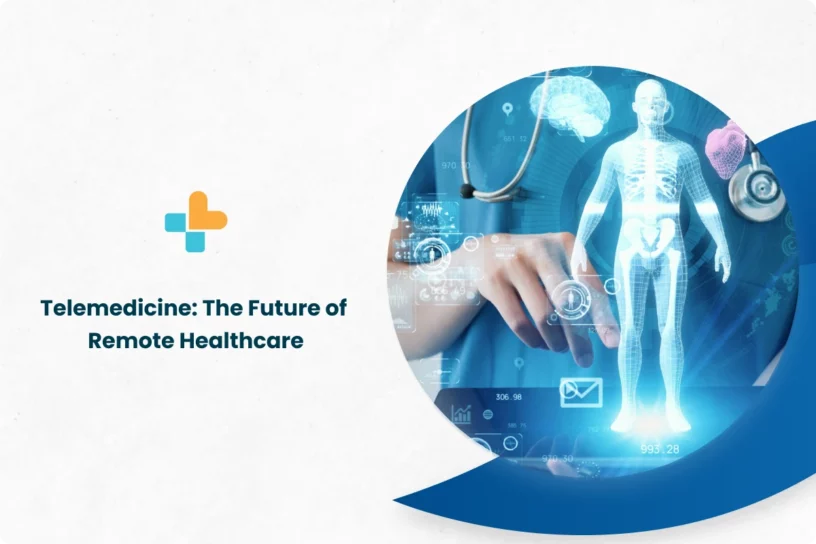The world has been facing unprecedented challenges due to the COVID-19 pandemic, and healthcare is one of the sectors that have been most affected. Social distancing has become the norm, and people are encouraged to avoid crowded places, including hospitals and clinics. This situation has led to an increased demand for remote healthcare services, which has made telemedicine the future of healthcare.
Telemedicine is the use of telecommunication and information technologies to provide healthcare services remotely. It allows healthcare providers to diagnose, treat, and monitor patients from a distance, using video conferencing, online consultations, and remote monitoring devices.
Telemedicine has been around for a while, but its adoption has been slow due to several factors, including regulatory barriers, lack of infrastructure, and resistance from healthcare providers. However, the COVID-19 pandemic has forced the healthcare industry to accelerate the adoption of telemedicine to meet the growing demand for remote healthcare services.
Benefits of Telemedicine
Increased Access to Healthcare Services
Telemedicine makes it possible for patients to access healthcare services from anywhere, at any time, using their smartphones or computers. This is particularly beneficial for patients in remote areas or those with mobility issues.
Cost-Effective
Telemedicine is cost-effective, both for patients and healthcare providers. Patients can save money on transportation and accommodation costs, while healthcare providers can reduce their overhead costs by providing remote services.
Improved Quality of Care
Telemedicine allows healthcare providers to monitor patients remotely, reducing the risk of infections and improving the quality of care. It also allows healthcare providers to collaborate and share knowledge, leading to better outcomes for patients.
Increased Efficiency
Telemedicine can reduce waiting times, as patients can be seen remotely, without the need for physical appointments. It also allows healthcare providers to see more patients in a shorter time, increasing efficiency and productivity.
Challenges of Telemedicine
Infrastructure
Telemedicine requires a reliable and robust infrastructure, including high-speed internet connectivity, secure data storage, and remote monitoring devices. This can be a challenge, particularly in remote areas with limited resources.
Regulatory Barriers
Telemedicine is subject to various regulatory barriers, including licensing, reimbursement, and liability issues. Healthcare providers need to comply with these regulations to avoid legal and financial risks.
Patient Privacy
Telemedicine requires the collection, storage, and transmission of sensitive patient information, raising concerns about privacy and data security. Healthcare providers need to ensure that their telemedicine platforms are secure and comply with relevant privacy laws.
Technical Issues
Telemedicine relies on technology, and technical issues such as connectivity problems, software glitches, and device malfunctions can disrupt the delivery of healthcare services. Healthcare providers need to have contingency plans in place to address these issues.
How does Telemedicine help in remote patient monitoring and improve chronic care management
Telemedicine has the potential to revolutionize remote patient monitoring and improve chronic care management. Here are some ways in which telemedicine can help in these areas:
Remote Patient Monitoring
Remote patient monitoring involves the use of technology to monitor patients’ health remotely, usually in their homes. Telemedicine can enable remote patient monitoring by using devices that can capture patients’ vital signs, such as blood pressure, heart rate, and blood glucose levels. These devices can transmit data to healthcare providers who can monitor patients’ conditions and provide timely interventions as needed.
Telemedicine can also enable virtual consultations between patients and healthcare providers, allowing patients to report symptoms, ask questions, and receive guidance on self-care. Virtual consultations can reduce the need for in-person visits, saving time and money for both patients and healthcare providers.
Chronic Care Management
Chronic diseases such as diabetes, heart disease, and hypertension require ongoing care and management. Telemedicine can help in chronic care management by providing patients with regular check-ins, reminders, and educational resources. This can improve patient engagement and help patients better manage their conditions.
Telemedicine can also enable healthcare providers to monitor patients’ conditions remotely and provide timely interventions as needed. For example, if a patient’s blood glucose levels are consistently high, healthcare providers can adjust the patient’s medication or provide lifestyle recommendations to help manage their condition.
In addition, telemedicine can enable healthcare providers to collaborate and share knowledge about chronic disease management. This can lead to better outcomes for patients and reduce the burden on healthcare providers.
Conclusion
Telemedicine is the future of healthcare, and its adoption is likely to continue to grow in the coming years. The COVID-19 pandemic has accelerated the adoption of telemedicine, highlighting its benefits and challenges. Healthcare providers need to embrace telemedicine to meet the growing demand for remote healthcare services and ensure that they comply with relevant regulations and privacy laws. With the right infrastructure, policies, and technology, telemedicine can transform healthcare delivery and improve the quality of care for patients.
Telemedicine has the potential to transform remote patient monitoring and chronic care management by providing patients with regular check-ins, enabling virtual consultations, and allowing healthcare providers to monitor patients’ conditions remotely. Telemedicine can improve patient engagement, reduce the need for in-person visits, and lead to better outcomes for patients with chronic conditions. As telemedicine continues to evolve, it is likely to play an increasingly important role in healthcare delivery.
Come be a part of this evolution in the medical industry with Telemedicine and get online consultation today!
Our Hospital Locations
General Surgery Hospitals in Chandigarh | General Surgery Hospitals in Bangalore | General Surgery Hospitals in Jaipur | General Surgery Hospitals in NCR | General Surgery Hospitals in Hyderabad
Our Doctors
General Surgery Doctors in Chandigarh | General Surgery Doctors in Bangalore | General Surgery Doctors in Jaipur | General Surgery Doctors in NCR | General Surgery Doctors in Hyderabad
About the Author

Dr. S. Goel
Dr. S. Goel is a renowned Internal Medicine Specialist currently practicing at Ayu Health, Bangalore. He is a Specialist in Internal Medicine, Diabetes HTN, Paediatric Care, and Family Medicine.




